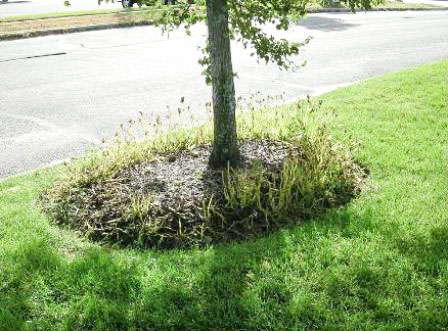Impatiens Downy Mildew: Is It Time Yet?

Exhibiting the stems-only stage Daughtrey describes in the story above. Photo courtesy of Margery Daughtrey, Cornell University.
A number of retailers recently asked me if they could start selling bedding impatiens again. The number of complaints were way down. People were not seeing nearly as many problems with impatiens downy mildew, and the demand (and pressure) on wholesalers and retailers was still very strong. The question in a nutshell was, “Is it time yet?”
Retailers and landscapers, more in the South than North, remember a plant called Red Tips (photinia). It was a ubiquitous shrub that was used in almost every landscape and residential site wherever it was hardy. You could not drive a block without seeing beautiful, red-tipped hedges or groups of plantings on restaurant, golf course and residential properties.
Then one year, a leaf blight (Entosporium) started, and with such a dense population, it spread rapidly. Airborne and soilborne spores made the disease particularly successful.
Within five years, nearly all the Red Tips had been removed. It was sad to see such beautiful plantings so decimated, but equally sad that retailers and growers lost such an important and profitable plant. There were no substitutes that provided the rapid growth and colorful foliage. Red Tips never recovered.
Fast forward 10 years. Today I do see some Red Tips here and there, and they are healthy and make a glorious display, as they always did. A few retailers are selling them again, essentially saying there are no problems with Red Tips in the neighborhood — maybe it has passed. Pathologists and plants people will say there are few problems because there are few Red Tips. The sheer size of the population made infection easy, rapid and extreme. Those left standing may have some degree of resistance, but are healthy mainly because the germplasm population is under control.
Has Enough Time Passed For Bedding Impatiens?
The situation is similar with Impatiens walleriana. Fortunately, not every region has been infected with downy mildew, but for those that have, it has been too short of a time period between the pandemic and reintroduction. There are fewer problems in infected areas because most retailers and growers stopped selling/producing impatiens, and the host population dramatically fell.
So here are my thoughts for 2015 on bedding impatiens in a non-perfect world.
1. Breeders are trying to breed for resistance. This does not happen overnight and is likely a few years away.
2. Growers, breeders and retailers should continue to look for substitutes in begonias, New Guinea impatiens and other genera. Breeders who can come up with a seed-propagated New Guinea impatien that remains short, tolerates shade and flowers well will be golden.
3. If retailers must sell bedding impatiens, recommend planting them in containers and baskets only. This will not prevent infection if there are lots of spores floating around, but it will slow it down. People may not pay attention to your recommendations, but you are educating them as best as you can.
Bedding impatiens are too important to disappear like Red Tips. They are far easier to hybridize, trial and work with than a woody shrub. I am confident breeding, selection and proper management will reduce the severity of the impatiens gap in good time, but no, it is not yet time to put them in the starting lineup.










